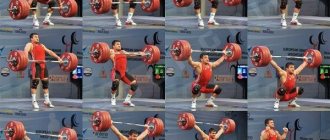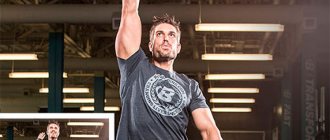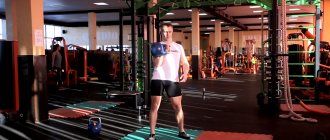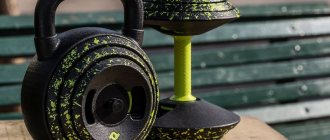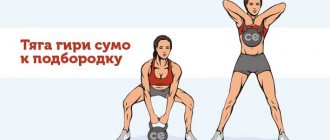Most athletes today build their training program around machines and exercises with dumbbells and barbells, ignoring the kettlebell. This attitude towards the projectile is absolutely unfair. There are exercises that can be performed using a kettlebell, but not with a barbell or dumbbell. A distinctive feature of this sports equipment is its compact size, characteristic grip, and special distribution of loads. For versatile training, the kettlebell is simply irreplaceable and should definitely take its place of honor in the arsenal of every person seriously passionate about sports.
There are two main kettlebell exercises - the clean and jerk and the snatch. Each is worthy of its own article, but today's is dedicated to the latter. Performing a snatch is much more difficult than a clean and jerk. This feature is due to the need to perform one movement - lifting the projectile from the bottom to the top point. The implementation of the jerk takes place without any intermediate stages, unlike the jerk, where the projectile is transferred to the chest and held before the final lift. To perform this movement, you need to have good coordination. All muscles must work harmoniously and connect in a timely manner.
What muscles work?
It is a mistaken opinion that during a kettlebell jerk the main load falls exclusively on the forearms. When performing the exercise, the main muscle groups involved are the legs and back. The core muscles are the most loaded.
The kettlebell snatch requires the involvement of the entire muscular frame. It is not carried out using brute force, but requires coordinated and technical work. The exercise not only uses strength and power, but also promotes the development of good coordination and muscle dynamics. It brings the greatest benefit to the muscular postural layers - deep skeletal.
Getting good results from the kettlebell snatch takes time and consistency. If you include it in your training program on an ongoing basis, you will soon see an increase in the power of the muscle groups involved in the work.
Push training in kettlebell lifting
There are many different approaches to training the jerk in kettlebell lifting, but it is impossible to say with certainty which of these approaches is better and which is worse. Everyone can find something for themselves, the main thing is to get to know yourself and try, compare, and draw conclusions.
Today we are going to Abakan (Republic of Khakassia), and we will take a closer look at how Russian MS Alexander Volodko trains the clean and jerk, whose results in the clean and jerk are simply impressive (126 reps with 32 kg weights). Alexander is the bronze medalist of the 2015 Russian Championship among juniors, the silver medalist of the 2014 Russian Championship among juniors, and also has many medals at the All-Russian level.
Alexander's approach is quite specific. He bases almost everything on a repetitive training method.
The repeated method is repeated performance of approaches with increased intensity and rest intervals between approaches, determined by the athlete’s well-being. For example, one approach is done in the clean and jerk for 3-4 minutes, then the athlete fully recovers (as opposed to the interval method), after which he proceeds to the next approach with the same intensity.
Let's move straight to the words of Alexander himself!
Variations of the exercise
You can perform a jerk in different ways:
Option 1. Experienced athletes with good physical training can do a more complicated snatch. when it is carried out without involving the legs, but solely by the strength of the back muscles. This becomes possible, for example, when sitting on a chair, which does not allow the use of the lower limbs.
Option 2. Involves using two shells at once. They can rise either simultaneously or in turn on each hand.
You should understand the difference between a jerk and a pull. The latter is not performed through inertia, which allows the weight to fly up, but is carried out through muscle effort. This is a completely different exercise.
Kettlebell Snatch - technique from the Guinness Book of Records record holder
Example workout
Kettlebells are convenient because they take up very little space, so you can exercise with them both in the gym and at home.
We start each workout with a warm-up; this is necessary to prepare the muscles, avoid injuries, and warm up the ligaments and joints.
We stretch the neck by tilting the head back and forth and left and right. We swing our arms, rotate our forearms and hands. We squat two sets of 10-15 repetitions, do hyperextension two sets of 10 times. We lean forward, backward and left and right.
Beginners need to start training with exercises:
- Squats with kettlebells.
- Mahi.
- Pulls to the chin.
- Kettlebell press.
This will strengthen the muscles of the arms and back and prepare the body for correct movements during the snatch and push. Experienced athletes can use the listed exercises as warm-ups.
Example workout for beginners:
- Warm up.
- Squats with a kettlebell in front of you, 3 sets, 20 reps each. Girls just need to take 16 kilograms with both hands in front of them. For men, squats with two 16 kg weights on the chest are suitable.
- Kettlebell swings – 3 sets of 20 reps
- Rows to the chin – 3 times 20 repetitions
- Press – 3 sets of 10-15 reps.
Example training for experienced athletes:
- Warm up.
- Squats holding a weight above your head for 30 seconds on each arm.
- Swings with changing hands – 2 minutes.
- Snatch – 2 minutes with each arm.
- Hold 2 weights on the chest – 2 sets of 1 minute.
- Chest push – 2 minutes per arm.
- Chest cleans – two minutes with each arm.
This workout can be done both in the gym and at home.
In the gym, exercises with kettlebells can be combined and included in bodybuilders’ training complexes to develop endurance, speed and coordination. For example, after leg training, perform kettlebell swings 3 sets 15-20 times.
If these workouts seem easy to you, simply increase the intensity of the lifts or add a minute to each set.
Approaches and repetitions algorithm for compiling a training complex
- Determine your maximum - perform the exercise to the limit, and remember the number of repetitions.
- Build your workouts based on this maximum, performing 60-80% of the previously established maximum repetitions in each working approach.
- Rest between working approaches from 2 to 5 minutes. During this time, you need to completely restore your breathing.
- Gradually increase the number of repetitions each workout. Watch your health, don't overdo it.
The number of working approaches when working out with weights ranges from 2 to 5. The number of repetitions will depend on your fitness, but should not be less than 15. Before starting each new exercise, do 2 warm-up approaches of 6-10 repetitions each.
What weight to take: 4, 8, 16, 24 or 32 kg
Choose the weight based on the number of repetitions; if you can’t do 15 repetitions, then the weight of the projectile needs to be reduced.
For young people, it would be wise to start with 16 kilograms for two-arm movements and 8 kilograms for one-arm movements. If the young man is well physically developed, you can start with 16 kilogram weights.
It is better for beginner girls to try with a 4 or 8 kilogram weight, depending on their preparedness.
First of all, hone the correct technique and only then increase the load. When training with kettlebells, it is not necessary to increase the weight of the apparatus each time. It is enough to increase the intensity of movements.
Correct technique for performing a kettlebell snatch
Phases of the jerk: 1 - start, 2 - swing, 3 - undermining, 4 - sitting down, 5 - fixing, 6 - lowering, 7-9 - swing to change hands, 10-13 - performing a jerk with the second hand.
The exercise is quite difficult. It is carried out in one movement, but in several stages:
The first phase is “Start”. The athlete returns to the starting position. The weight lies on the floor and is located at an equal distance from the legs, which are spaced slightly wider than the shoulder girdle.
Second phase “Swing”. You need to sit down a little, taking the projectile with your hands. You should not bend over, as this will not allow your leg muscles to engage in active work. The free hand should not encounter obstacles or rest on anything. Otherwise, the balance will be disturbed as a result of the fact that she was in front.
The body must not interfere with the movement of the weight, but accompany the projectile. This moment is especially difficult for beginners who stop the backward movement of the projectile, making their own jerk, and do not lead it to the end.
A correct swing assumes that the kettlebell, having reached the extreme point at the back, will begin to move forward (according to the law of the pendulum), therefore, with the explosive force of the back and legs, you need to give it even more additional energy.
Third phase "Detonation". Having the weight in front of the athlete is a “signal” to straighten the legs and tilt the body back to give the apparatus the power necessary to complete the upward movement. No other efforts can be made.
The lack of disruptive energy does not allow you to make a breakthrough in any situation. Trying to lift a kettlebell up using your own efforts increases the risk of injury. When at this phase at the lowest point the efforts are not enough, the projectile will fly upward on its own. All that remains is to accompany him with your body and hand.
There is no need to hold the kettlebell with a death grip. It is enough to grasp the projectile with your fingertips. Of course, you can’t relax your grip too much so that the kettlebell just goes into free flight.
The fourth phase is “Squad”. An optional stage, which is not present in every variety, but is mandatory in the classic version of the snatch. Otherwise, he will cease to be such. When the weight is as close as possible to the highest point, you need to bend under the projectile, that is, catch it.
Performing a squat allows you to take as much weight as possible and also significantly save energy. This is especially important for those who need to pass standards.
Squats are needed to cushion a heavy projectile. They help reduce the negative load placed on the joints. Anyone who wants to learn how to do a jerk should definitely master this phase.
Fifth phase “Fixation”. When squatting, the apparatus is twisted in such a way that it becomes possible to hold the weight at the upper extreme point. There are different ways to do this. The choice depends entirely on the wishes of the athlete and how easy it is, taking into account the anatomical features, to make this or that fixation.
The constant point of this phase is that fixation of the projectile in the hand must be ensured even before the end of the movement. At the very end, you need to fully straighten your arm. This should not be done too early. Completing the movement with the arm already straight will cause serious damage to the shoulder and elbow joints.
They experience a lot of stress even when the fixation is performed absolutely correctly. When doing the snatch, you should pay special attention to stretching and strengthening the shoulder and elbow joints. You need to take care of the carpal ligaments. They must be stretched. When the weight is held at the end point, they bend back.
When the athlete stands with the kettlebell held with an outstretched arm, he should lean forward slightly. This allows you to maintain balance.
Sixth phase “Lowering”. It can be carried out in two ways - directly on the floor surface or with a transitional movement, when the projectile is first “placed” on the chest, and only then lowered, that is, similar to a push.
Competing athletes practice exclusively the first option. For athletes who do not demonstrate this exercise in competitions, the second method is more suitable. It's much safer. Regardless of the option you choose, you should not throw the projectile.
The kettlebell should always be cushioned by the body. If the movement is sudden and uncontrolled, the likelihood of injury increases. A falling weight can easily cause a lot of damage.
Kettlebell Snatch - Technique. Crossfit
Equipment for kettlebell lifting
Sports equipment plays an important role in preparing for and performing in competitions. Proper clothing and shoes reduce the possibility of injury to zero and also make it easier and safer to perform exercises. Mandatory equipment attributes approved by the rules of kettlebell lifting:
Shoes – weightlifting shoes. Special shoes for weightlifters also came into weight lifting. The ankle boots are made of thick leather with lacing along the entire length and are capable of fixing the ankle joint in a stationary position, avoiding dislocations. There is also a 2 cm heel.
Weightlifting belt. A wide leather belt (no more than 12 cm wide) is able to fix the lumbar spine and avoid injury and deflection in the lower back.
T-shirt and bike shorts. The shirt should not cover the elbow joints, so the sleeve should be 10 cm above the elbow (according to the rules of kettlebell lifting). Bicycle shorts should also allow you to view the fixation of the knee joints.
Elastic bandages. Used to fix knee joints and prevent injuries.
Wristbands. Used to fix the wrist and prevent pain. According to the rules of the sport, wristbands or short elastic bandages for the wrist should not exceed 10 centimeters in width.
General recommendations for performing the kettlebell snatch
To quickly master the technique and prevent injuries, just follow a few simple tips:
- It is best to hone the technique on a light weight projectile, but it must be noticeable. The best option for women would be a ten-kilogram weight, for men - sixteen kilograms.
- Beginners who want to master the snatch should thoroughly work out their muscle frame. Otherwise, you simply won’t be able to complete the exercise. Performing deadlifts and standing presses with a barbell, as well as jerking and lifting weights on the chest, will allow you to cope with this task perfectly.
- No tearing or straining forces should be allowed when performing any phase. You need to make sharp, clear and coordinated, slightly smooth movements.
- You need to be careful to keep your free hand relaxed, but not flailing or twitching. You should not forcefully hold it in one position. The main thing is that it should not interfere with muscle work and overexert itself.
The duration of each jerk is largely determined by the athlete’s own endurance. The approach time can vary between 3-15 minutes.
Federation[ | ]
Main article: International Kettlebell Lifting Union
Main article: All-Russian Kettlebell Lifting Federation
The European Kettlebell Lifting Union (EKLU) was created in 1992 on the initiative of the Baltic states. Lithuania, Latvia, Estonia, Russia, Ukraine, and Belarus took part in its work. ESGS was the first international organization in kettlebell lifting. On October 29, 1992, the International Kettlebell Lifting Federation (IFGS) was created, which included seven countries that were former republics of the USSR. The first European Kettlebell Lifting Championship took place in 1992, the first World Championship in 1993, and the first World Cup in 1994. These two structures (USGS and MFGS) worked in parallel, according to their powers. In 2007, the MFGS was dissolved, and the ESGU was reorganized into the International Kettlebell Lifting Union (IKWS) with headquarters in Latvia.
The main Russian organization is the All-Russian Kettlebell Lifting Federation (VFGS). VFGS is a member of the International Union of Kettlebell Lifting.
The International Kettlebell Lifting Union (IUKL) has been a member of TAFISA since 2009.
In 2022, an alternative federation, the World Kettlebell Sport Federation (WKSF), was created. Federation President Oleg Ilica (Italy) Vice President Ivan Denisov (Russia). The 2022 WKSF World Championships took place in Italy, and in 2022 in Ireland.
There is also another federation, WAKSC, focused on club kettlebell lifting.
General information
The kettlebell push is a general name for a group of basic impulse-type exercises. It is rarely used in modern fitness due to the lack of suitable equipment in most gyms. Unlike other exercises in CrossFit, the push is used not as a basis, but as an auxiliary exercise that helps strengthen the ligamentous apparatus
Another important feature is the powerful pumping of the heart. Since all the complexes are multi-repetitive, it perfectly works the heart muscle without increasing the peak heart rate to a critical point.
Despite its high efficiency, the push has its drawbacks:
- Inability to scale. This is due to the fact that weights, unlike dumbbells, are always of a fixed size - 8, 16, 24, 32 kg.
- High risk of injury. Associated with the pulsed nature of the load.
- Complex exercise technique. Requires control not only of your hands, but also of your back.
- Large load on the wrist bones. Therefore, at first, the size of the projectile is limited not by strength, but by the strength of the bones.
Kettlebell lifting is a time-tested functional training
The kettlebell, as a sports equipment, was invented by Russian gunners in the 17th century.
At that time, soldiers serving artillery pieces required considerable strength and dexterity in order to lift and transfer cannonballs, as well as clear the cannon barrel.
That’s when they came up with the idea of attaching a cannonball to the core and training during hikes in order to reload the cannon faster and get tired less.
Later, for a long time, the weight was used as a circus apparatus for strongmen, and a separate sport as such did not yet exist. Only in the late 40s of the last century did kettlebell lifting begin to take shape and develop, first in the Soviet Union, and then throughout the world.
Advice
Nowadays, the kettlebell is a very popular training item not only for athletes - kettlebell lifters, but also for MMA fighters, representatives of crossfit and other fitness methods. In addition, a separate sports direction appeared in the USA - kettlebell fitness, which significantly increased the popularity of this equipment.
The best exercises with kettlebells
Key Benefits of Kettlebell Training
Why is the kettlebell so good and what are the main advantages of using it in strength training?
The fact is that the weight's center of gravity is shifted when working with it. This allows you not only to work the muscles in completely different planes and perform exercises characteristic only of this apparatus, but also to load numerous stabilizer muscles. A similar effect is almost impossible to achieve by performing the same exercises with ordinary dumbbells.
As for kettlebell lifting, in our time it consists of 2 disciplines:
Classic double-event, consisting of a kettlebell snatch with one hand and a push of two kettlebells from the chest with both hands. Push the weights through a full cycle (with lowering between the legs).
Long cycle kettlebell pushing technique:
There is a standard (competition gradation of weights by weight): 16 kg (1 pood), 24 kg (1.5 poods), 32 kg (2 poods), but for training you can also use weights with intermediate weights.
Each exercise at the competition is given 10 minutes to complete, during which you must complete as many repetitions as possible.
Performing these exercises not only loads almost the entire body of the athlete, but also significantly develops strength endurance, explosive power, cardiovascular system, as well as serious willpower, since doing a few more repetitions in the last minutes when the whole body is completely tired is very difficult. Therefore, the main emphasis in training athletes is on developing the functional capabilities of the body.
– leg muscles (quadriceps, calves);
– back muscles (extensors);
– muscles of the shoulder girdle;



